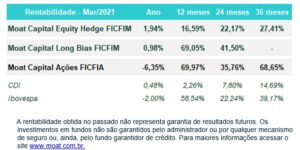Letter to investors – 1st quarter 2021
Dear shareholders,
The first quarter of the year was especially hard for Brazil, given the worsening of the pandemic, which showed a significant increase in the number of deaths and hospitalizations and, consequently, increased isolation to reduce the burden on the health system. As if this great challenge were not enough, the various noises coming from Brasilia and the fragility of the fiscal framework were added, causing us to detach ourselves (even more) from the global markets, which remain very optimistic and with high complacency.
In this letter, we would like to explore precisely the difference in expectations between the domestic and global scenario, but also seek to understand how much of these scenarios are incorporated into prices. The perception of global recovery as well as our challenges are relatively clear topics. However, our role as managers is centered on understanding where the best asymmetries, opportunities and risks lie.
The world, especially the United States and England, continues with great optimism, as a result of the vaccination campaign and the consequent reopening of the economies that, together with the monetary and fiscal stimulus package, should result in growth rarely seen in history.
Since the beginning of the pandemic, the great driving force of the markets has been the high (and unprecedented in history) injection of resources by governments, further inflating asset prices. We observe this movement with great caution, as we understand that the capital flow must undergo a significant reorganization. While in the cycle from 2008 (post financial crisis) to 2020 (pandemic) we saw a market driven by liquidity and low interest rates due to an environment with low inflation, the current cycle presents different characteristics and, therefore, it does not seem to us that we will have the same dynamics observed before the pandemic.
We see a noticeable worsening of risk asymmetry in the US stock market, as assets already largely reflect such recovery. During the month of March, US debt securities had a strong devaluation (increase in the nominal rate), leading to a realization in risky assets, mainly those with higher implicit embedded growth (growth stocks). We understand that this movement may be more acute and structural as inflation starts to become more visible, raising interest/capital costs.
Commodities, both metallic and agricultural, were also favored by this dynamic and add an ingredient of risk to global inflation. One of the explanations for this movement is the fact that, as usual, China has resorted to a strong fiscal package to mitigate the impacts of the crisis, unbalancing the balance of supply and demand for the main commodities. The economic recovery already underway should make the government reduce such stimuli; and so prices in this group are likely to face some resistance in the coming months, despite the global economic recovery.
In Brazil, however, we had a major setback in expectations with the new economic closures and the pressure from the political class to spend in a challenging fiscal regime. Our weaknesses were evidenced mainly in the exchange rate, which continued to show devaluations throughout the first quarter, despite the strong rise in commodities. The same happened with the interest curve, which considers Selic increases far beyond what is “reasonable”. Deterioration from these levels seems possible to us only if we abandon the current fiscal rules. We must not forget that we will probably have a 2021 with one of the best results in the balance of payments and a record in the balance of trade – remembering that the country does not have indebtedness in US currency.
In this context, the local stock market also disconnected from global markets. Although a few names posted significant increases – most companies linked to the commodity cycle and the dollar – in general the stocks performed poorly.
Despite the enormous challenges presented, when we look at the companies in detail, we see that the balance sheet of listed companies, in general, has never been so healthy, as most of them took advantage of this recent window of liquidity in the capital market to capitalize. Another important point that is worth drawing attention to is that Brazilian stocks are cheap, both from an absolute and relative perspective.
In Brazil, disbelief with the political scenario and the lack of perspective for reforms placed the Brazilian stock market at a great discount, despite the good financial health of the companies and a contracted cyclical recovery. Our currency had a depreciation that already incorporates, to a large extent, fiscal risks and shows us a good relationship risk x return.
In short, we find a great dichotomy between setting and price when we confront the world, especially the US, and Brazil. In the US, the recovery trajectory is solid and crystal clear, and assets are priced almost perfectly, not incorporating the various associated risks. Meanwhile, in the domestic environment, our view is that a number of risks are already embedded in prices, although our fiscal challenge is significant.
Additionally, we cannot lose sight of the long-term impact generated by huge incentives and their effects on the dynamics of capital allocation globally.

Graciously,
Moat Capital